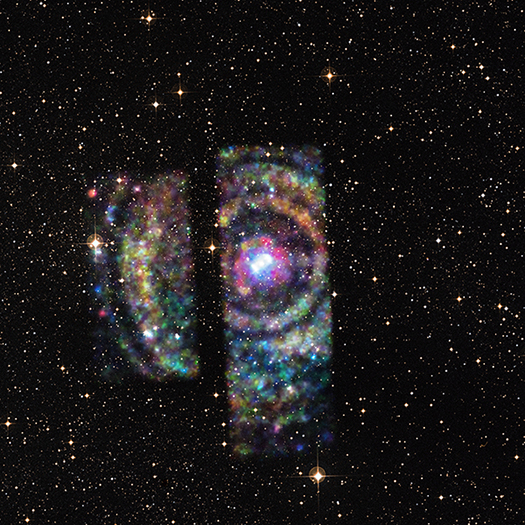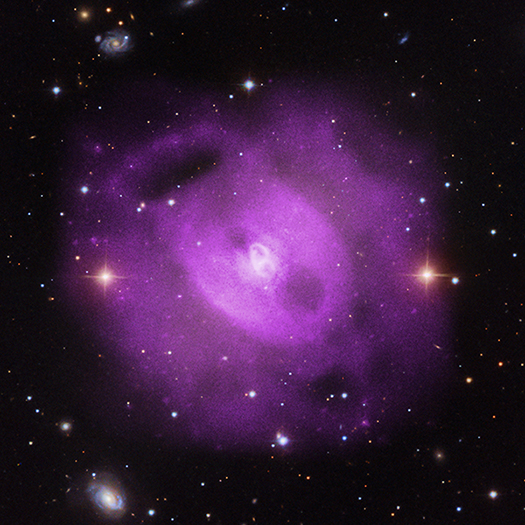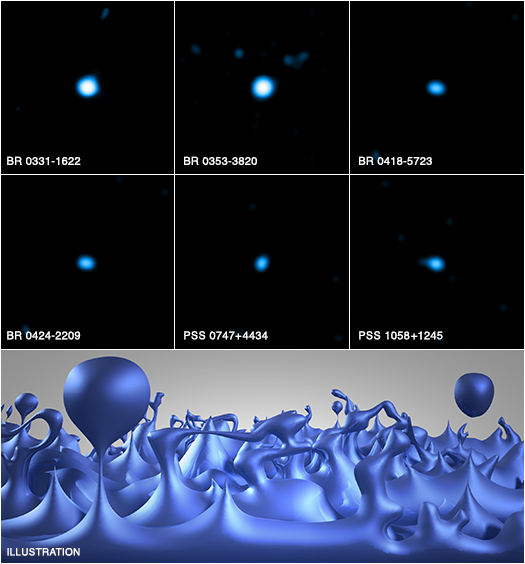X-ray Echoes Pinpoint Location of Distant Flaring Neutron Star
Data from NASA's Chandra X-ray Observatory has helped provide a rare opportunity to determine the distance to an object on the other side of the Milky Way galaxy, as described in our latest press release
Chandra Finds Evidence for Serial Black Hole Eruptions
Astronomers have used NASA's Chandra X-ray Observatory to show that multiple eruptions from a supermassive black hole over 50 million years have rearranged the cosmic landscape at the center of a group of galaxies.
Scientists discovered this history of black hole eruptions by studying NGC 5813, a group of galaxies about 105 million light years from Earth. These Chandra observations are the longest ever obtained of a galaxy group, lasting for just over a week. The Chandra data are shown in this new composite image where the X-rays from Chandra (purple) have been combined with visible light data (red, green and blue).
The Great and the Small: Is Quantum Foam Losing its Fizz?

Eric Perlman
We are very pleased to welcome Eric Perlman as a guest blogger today. He led the study setting limits on the foaminess of space-time that is the subject of our latest press release. Eric is a professor at the Florida Institute of Technology. After completing his PhD in 1994 at the University of Colorado, he held postdoctoral fellowships at the Goddard Space Flight Center and Space Telescope Science Institute. He also held research positions at Johns Hopkins University and the University of Maryland, Baltimore County. He has lived in Florida for 8 years and enjoys his family, singing, and playing chess and other board games.
Astronomy has been a tool of discovery since the dawn of civilization. For thousands of years, humans used the stars to navigate and find their place in the universe. Astronomy made possible the travels of the ancient Polynesians across the Pacific Ocean as well as measurements of the Earth’s size and shape by the ancient Greeks. Today, astronomers search for hints about what the universe was like when the universe was much younger. So imagine, for a second, what life would be like – and how much less we would know about ourselves and the universe – if the microscopic nature of space-time made some of these measurements impossible.
NASA Telescopes Set Limits on Space-time Quantum Foam
A new study combining data from NASA's Chandra X-ray Observatory and Fermi Gamma-ray Telescope, and the Very Energetic Radiation Imaging Telescope Array (VERITAS) in Arizona is helping scientists set limits on the quantum nature of space-time on extremely tiny scales, as explained in our latest press release.
Certain aspects of quantum mechanics predict that space-time - the three dimensions of space plus time -- would not be smooth on the scale of about ten times a billionth of a trillionth of the diameter of a hydrogen atom's nucleus. They refer to the structure that may exist at this extremely small size as "space-time foam." This artist's illustration depicts how the foamy structure of space-time may appear, showing tiny bubbles quadrillions of times smaller than the nucleus of an atom that are constantly fluctuating and last for only infinitesimal fractions of a second.
Light: Beyond the Bulb at Puerto Rico
During the month of April 2015 the Chandra exhibit "Light: Beyond the Bulb" for the International Year of Light was displayed at the main library of the University of Puerto Rico (UPR) and impacted many hundreds of visitors. The exhibit was announced to the public using different media with the support of the Communications Office at the UPR. Dr. Gloria Isidro (Caribbean University) organized special talks at Caribbean University of Bayamón in which hundreds of students, faculty and staff participated (April 8th and 9th, 2015). These talks included a description of the goals of the International Year of Light 2015, announced the exhibit of images at the University of Puerto Rico during the month of April and showed a video of the "Light: Beyond the Bulb" exhibit.

X-ray Astronomy and #girlswithtoys
There have been so many excellent images and messages being tied to the hashtag #girlswithtoys on Twitter over the past several days. We would love to be able to take some selfies with some of the many female scientists, engineers, and other professionals who use and run the Chandra X-ray Observatory. (Of course, the Director of Chandra is Belinda Wilkes, the first woman to lead one of NASA’s Great Observatories) Unfortunately, Chandra is currently in its highly elliptical orbit that takes it a third of the way to the Moon, so the spacecraft is unavailable for a snapshot.
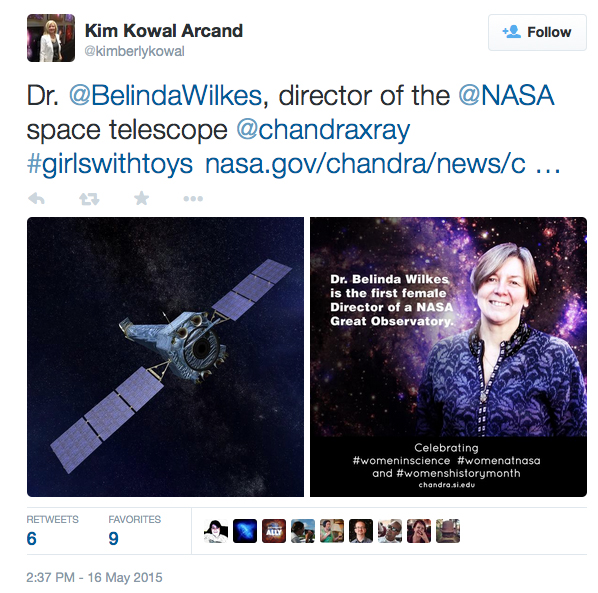

Magnetar Near Supermassive Black Hole Delivers Surprises
In 2013, astronomers announced they had discovered a magnetar exceptionally close to the supermassive black hole at the center of the Milky Way using a suite of space-borne telescopes including NASA's Chandra X-ray Observatory.
Magnetars are dense, collapsed stars (called "neutron stars") that possess enormously powerful magnetic fields. At a distance that could be as small as 0.3 light years (or about 2 trillion miles) from the 4-million-solar mass black hole in the center of our Milky Way galaxy, the magnetar is by far the closest neutron star to a supermassive black hole ever discovered and is likely in its gravitational grip.
Supermassive Black Holes Running at Full Tilt

Bin Luo
We are very pleased to welcome Bin Luo as a guest blogger today. He led the study on supermassive black holes that is the subject of our latest press release. Bin obtained a PhD degree in Astronomy and Astrophysics from the Pennsylvania State University in 2010, working on the Chandra Deep Field surveys. He then worked as a postdoctoral fellow at the Harvard-Smithsonian Center for Astrophysics, and later back at the Pennsylvania State University. He will start a faculty position in September 2015 at the Nanjing University in China. Bin has mainly been working on X-ray studies of supermassive black holes in the centers of galaxies. He is now leading the data analysis of the 7-million-second (81 days) Chandra Deep Field-South survey, the deepest Chandra observation ever performed.
I have been studying the X-ray emission from accreting supermassive black holes since I was a graduate student. These monstrous black holes – quasars fueled by large amounts of gas and dust, consuming of the order of a couple solar masses per year – are known nearly universally to be strong X-ray emitters. Meanwhile, strong line emission – that is, light coming from a narrow range of wavelengths – is also a hallmark of quasar spectra in optical and ultraviolet bands. Therefore, I was quite puzzled when we discovered that a small group of quasars with remarkably weak ultraviolet line emission are often extremely X-ray weak. The pioneering work was led by Jianfeng Wu, Niel Brandt, and Pat Hall in 2011 and 2012, where the X-ray emission from 19 such quasars was examined. What makes things even more interesting is that for a subgroup of these quasars selected with refined ultraviolet properties, almost 100% are weak in X-ray light.
NASA's Chandra Suggests Black Holes Gorging at Excessive Rates
Astronomers have studied 51 quasars with NASA's Chandra X-ray Observatory and found they may represent an unusual population of black holes that consume excessive amounts of matter, as described in our latest press release. Quasars are objects that have supermassive black holes that also shine very brightly in different types of light. By examining the X-ray properties with Chandra, and combining them with data from ultraviolet and visible light observations, scientists are trying to determine exactly how these large black holes grow so quickly in the early Universe.
Chandra Science on State Street
Hundreds of explorers converged on the campus of Framingham State University in Massachusetts on Saturday, April 25, 2015 to take part in the first annual Science on State Street festival.
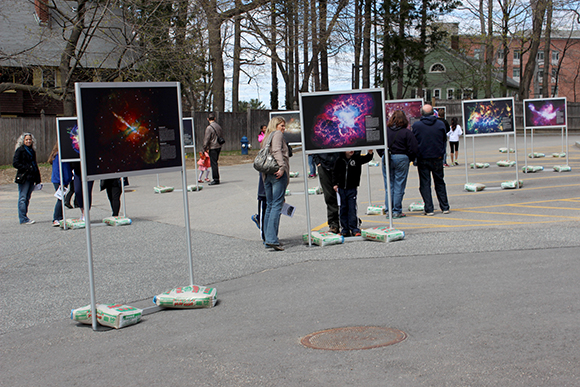
The family-focused event offered up a variety of interactive STEM-themed learning stations addressing aspects of chemistry, astronomy, biology, engineering, robotics and more, arranged outdoors across the University’s shady upper campus. We estimate between 500 and 600 visitors overall to the event.

